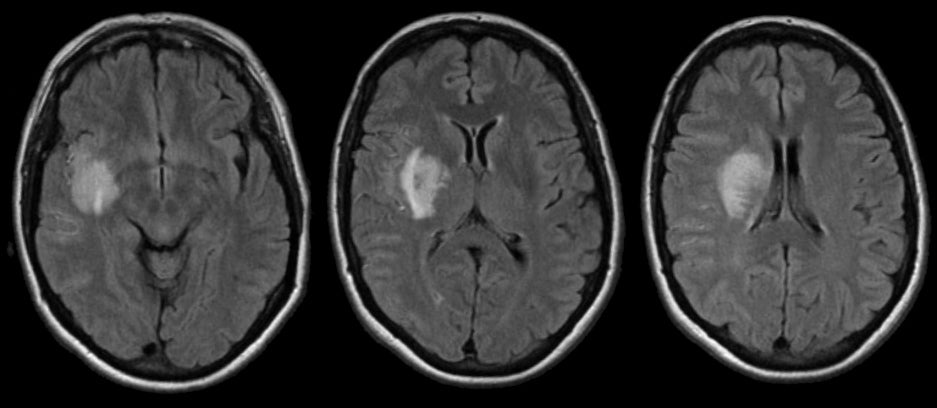

![]()
| Watershed Infarction:
Flair axial MRI scans. Note the large bright signal in the right basal ganglia and internal
capsule. Although watershed infarcts are most often thought of as areas between two major
blood vessels, there is a deep watershed area between the superficial cortical
arteries and the deep penetrating arteries that are both terminal branches of
the middle cerebral artery. Thus, a large,
deep infarct of this size can be caused by large vessel disease of the middle
cerebral artery (i.e., thrombosis or
embolus) and not by disease of small penetrating arteries that result in lacunar strokes,
which are much smaller. These lesions are sometimes referred to as giant lacunes,
as well as other names, such as "lagoons." The area between two vascular territories is known as a watershed. Watershed infarcts typically occur following reduced perfusion pressure, often secondary to cardiac events or severe bleeding. In those cases, they are usually bilateral. When a watershed infarct is seen unilaterally, this is usually due to hemodynamic narrowing of a proximal artery without intact collateral vessels (e.g., an incomplete circle of Willis), with or without superimposed hypotension. Most commonly, these involve the distal territory of the carotid artery. Thus, if a patient has severe, hemodynamically significant carotid stenosis, then ischemia first occurs between the terminal territories of the middle and anterior cerebral arteries on that side. The watershed territory between the MCA and ACA corresponds to the shoulder and hip girdle muscles on the motor homunculus, leading to a characteristic clinical deficit, weakness of the shoulder and hip girdle muscles bilaterally (often referred to as "the man in the barrel" distribution of weakness). There is also a watershed territory between the MCA and PCA. When an infarct occurs in this territory, patients typically develop bilateral cortical visual abnormalities, among them cortical blindness, Anton's syndrome (cortical blindness with denial/confabulation) and Balint's syndrome (asimultagnosia, optic ataxia, and gaze apraxia). Lastly, a watershed area exists between deep and superior cortical vessels. Most often, this is in the basal ganglia / internal capsule areas which are supplied by the lenticulostriates below and the cortical branches above. |
Revised
12/02/06
Copyrighted 2006. David C Preston